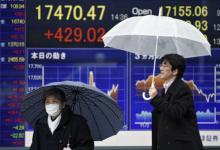
Typical street scene in Santa Ana, El Salvador. (Photo: iStock)
IMF Survey : Insurance Sector Contributes More Risk to Financial System since Crisis
April 4, 2016
- Life insurers’ role more important in financial system
- Insurers more exposed to economy-wide risks
- Monitoring common risk exposures key for supervision
Life insurers in major advanced economies have contributed more risk to the financial system as a whole since the global financial crisis, according to new research by the International Monetary Fund.

Pedestrians in Tokyo walk past a stock market board: low and negative interest rates in advanced economies are a source of risk for insurers (photo: Franck Robichon/Corbis)
GLOBAL FINANCIAL STABILITY REPORT
Insurers are large institutional investors holding over $24 trillion in global assets and longer-term liabilities, and they have become more exposed to swings in asset prices in recent years. This means that in the event of a large shock, such as a sharp drop in asset prices, insurers are unlikely to fulfill their role to channel savings to borrowers, precisely when other parts of the financial system may also fail to do so. Low interest rates are another important source of risk for insurers. And the lower the level of interest rates, the more vulnerable insurers become to further interest rate changes.
The analysis, part of the Global Financial Stability Report, suggests supervisors and regulators should tackle risks by looking more systematically at the role the insurance sector as a whole plays in the financial system, through a macroprudential approach.
The IMF said policymakers, regulators, and supervisors must go beyond guarding against the solvency and contagion risks of individual firms and address the fact that insurers are increasingly vulnerable to the same risks as other parts of the financial system.
The source of the risk
Changes in the investment behavior of insurers are not the main driving force behind this increase in systemic risk, according to the IMF. The share of higher-risk assets has remained broadly constant over time for insurers in the countries included in the analysis. However, there are notable firm-level differences: smaller, weaker, and less capitalized firms in a number of countries appear to have taken on more higher-risk asset investments in recent years to resurrect their fortunes.
Moreover, companies with a greater proportion of minimum investment-return guarantee products, such as investment-oriented life insurance policies with minimum guarantees or certain types of annuities, and higher levels of guarantees have investment portfolios with larger amounts of risky assets.
Life insurers have longer-dated liabilities than assets, so a drop in interest rates affects them adversely. The IMF said the prolonged period of very low interest rates has heightened this vulnerability, especially in the United States and Europe.
“Market-wide factors, such as higher observed correlations across asset classes, means large changes in asset prices affect life insurers in increasingly similar ways,” said Gaston Gelos, head of the Global Financial Stability Analysis Division at the IMF. “To some extent, these changed market dynamics are likely to be permanent.”
Other factors also may contribute to rising systemic risk, according to the IMF. Changes in product offerings, such as the increased reliance on annuities in the United States, may explain more sensitivity to low interest rates, and the use of derivatives may explain their greater exposure to the rise and fall in financial markets.
Policy lessons
These developments call for a greater emphasis on macroprudential policies. Insurance supervisors should look not only at individual companies (the microprudential approach), but also at commonalities and the impact among firms and countries. Measures designed to avoid insurers jointly curtailing their financing to the rest of the system could be helpful.
“One such measure could be capital buffers, which insurers can build up during economic upswings and use during downturns,” said Gelos.
Valuing insurers’ assets and liabilities at market prices can increase transparency and encourage greater asset-liability matching, according to the IMF. However, regulators must pair valuation rules with countercyclical measures, such as the type of adjustments foreseen in the European Union’s Solvency II regime, to avoid forced selling of assets by insurers in a downturn.
The analysis also suggests the need for attention to the performance and behavior of smaller and weaker firms. Even if less systemic individually, jointly such firms can propagate shocks if they act similarly. Moreover, they may be “too many to fail.”
The IMF will release further research from the Global Financial Stability Report on April 13.


